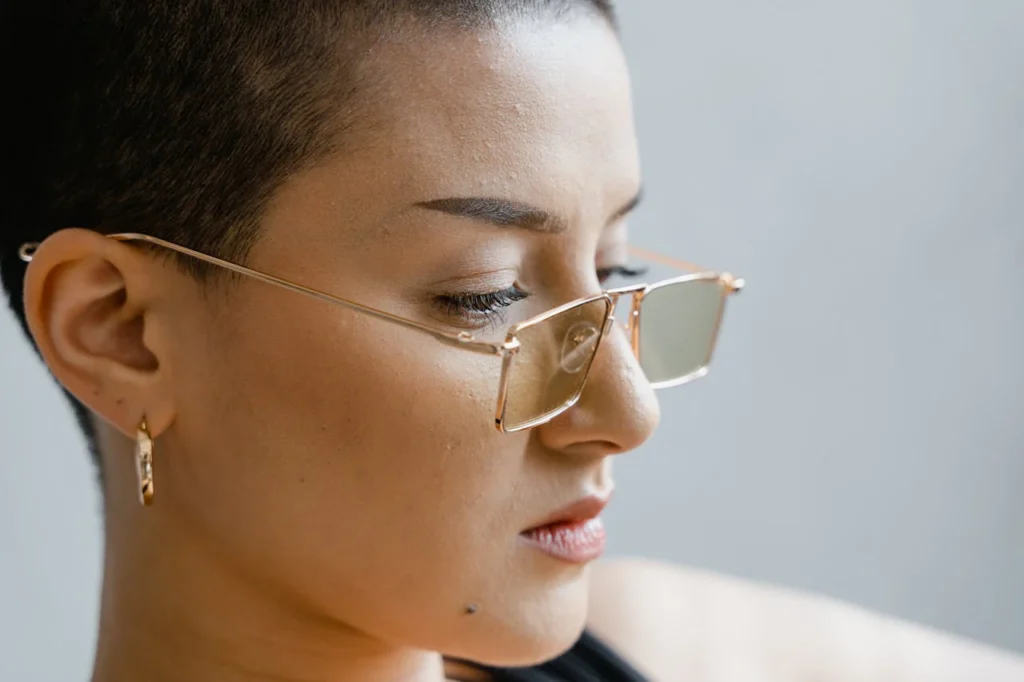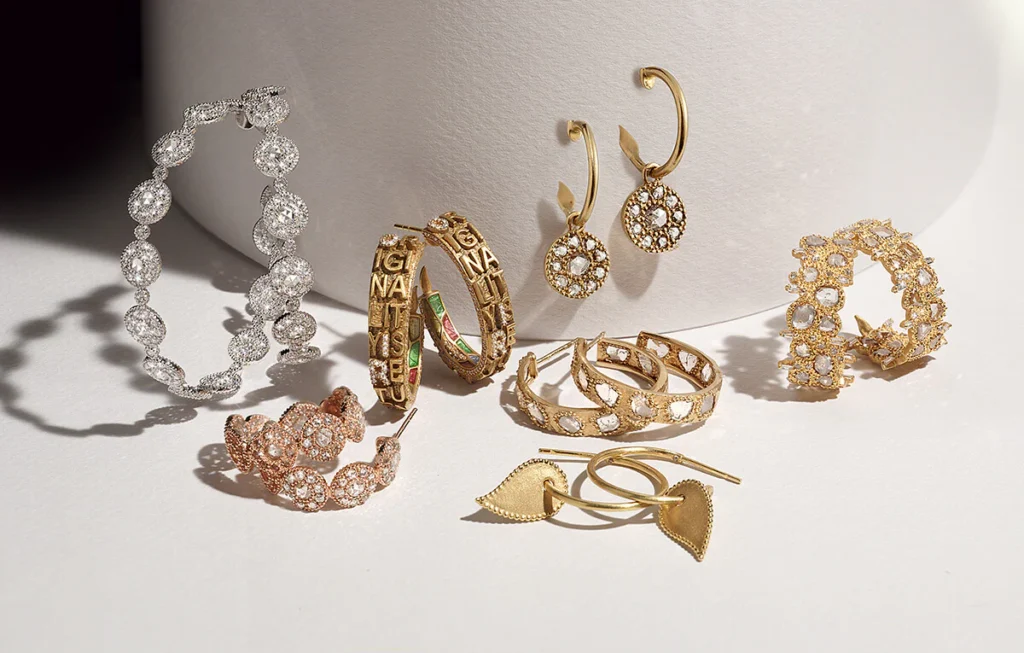Blog
The Evolution of Hoop Earrings: A Cultural Icon
Hoop earrings have transcended time, cultures, and fashion trends to become one of the most enduring and iconic jewelry styles in history. Their circular shape symbolizes unity, infinity, and timeless beauty, making them a staple in wardrobes around the world. From their ancient origins to their current place as a cultural and fashion statement, hoop earrings continue to evolve, carrying deep significance and style.
In this article, we’ll explore the evolution of hoop earrings, tracing their roots, cultural impact, and how they’ve become a symbol of empowerment and identity in modern fashion.
1. The Ancient Origins of Hoop Earrings
Hoop earrings date back thousands of years, with evidence of their existence found in some of the earliest civilizations.

1.1. Ancient Mesopotamia and Sumer
- Hoop earrings are believed to have originated around 2500 BCE in Mesopotamia.
- Both men and women wore hoops to symbolize social status and wealth.
1.2. Ancient Egypt
- In Egypt, hoop earrings were popular among both men and women, especially royalty and nobility.
- Gold hoops adorned with gemstones reflected the wearer’s wealth and divine connection.
- Egyptian queens, such as Cleopatra, famously wore elaborate hoop earrings as part of their regalia.
1.3. Ancient Greece and Rome
- In Greece and Rome, hoop earrings evolved into intricate designs, often featuring gold, silver, and pearls.
- They became a symbol of refinement and were commonly worn by aristocrats.
2. Hoop Earrings in Global Cultures
As civilizations spread and cultures blended, hoop earrings took on new meanings and designs.
2.1. Africa
- In African cultures, hoop earrings have long symbolized beauty, strength, and cultural identity.
- Tribes such as the Maasai use hoops made from natural materials like wood, bone, and metals to denote status and heritage.
2.2. Latin America
- In Latin America, hoop earrings (argollas) are deeply tied to cultural traditions.
- They are often passed down through generations as heirlooms, symbolizing family heritage and pride.
- Large gold hoops became a staple in traditional attire, especially for women.
2.3. India
- Hoop earrings are a traditional accessory in Indian culture, often embellished with intricate designs and gemstones.
- They are worn during weddings and festivals to signify prosperity and femininity.
2.4. Indigenous Tribes in the Americas
- Indigenous tribes in North and South America wore hoops as part of their spiritual and cultural expressions.
- Hoops symbolized unity and connection to the natural world.
3. The Resurgence of Hoop Earrings in the 20th Century
The 20th century saw hoop earrings reemerge as a major fashion trend, particularly in Western culture.
3.1. The 1920s and 1930s
- With the rise of Art Deco, hoop earrings became a popular accessory for glamorous evening wear.
- Celebrities and socialites embraced hoops, pairing them with flapper dresses and bold makeup.
3.2. The 1960s and 1970s
- Hoop earrings made a bold comeback during the 1960s, fueled by the rise of counterculture movements and the Civil Rights Movement.
- They were embraced by Black women as symbols of pride in African heritage.
- The 1970s disco era saw hoops become larger and more flamboyant, reflecting the exuberance of the time.
3.3. The 1980s and 1990s
- Hoop earrings became synonymous with hip-hop culture and urban fashion during the 1980s.
- Artists like Salt-N-Pepa, Janet Jackson, and Queen Latifah popularized oversized gold hoops as symbols of empowerment and confidence.
- In the 1990s, hoops maintained their popularity, taking on sleeker and more minimalist designs as part of the decade’s understated aesthetic.
4. Hoop Earrings as a Symbol of Empowerment
Hoop earrings have grown beyond their aesthetic appeal to represent strength, resilience, and identity, particularly for women of color.

4.1. Cultural Pride
- In Black and Latinx communities, hoop earrings are more than fashion; they are statements of cultural heritage and resistance.
- Women often wear hoops as a form of self-expression and pride in their roots.
4.2. Feminist Iconography
- Hoop earrings have become a symbol of feminist empowerment, often worn to challenge societal norms.
- The boldness of oversized hoops conveys confidence and defiance.
4.3. Celebrity Influence
- Celebrities like Beyoncé, Rihanna, and Jennifer Lopez have elevated hoop earrings as a statement of strength and glamour.
- These icons use hoops to celebrate their heritage while inspiring fans to embrace their individuality.
5. Modern Trends in Hoop Earrings
Today, hoop earrings remain a staple in contemporary fashion, with endless variations and styles to suit every taste.
5.1. Minimalist Hoops
- Thin, sleek hoops in gold or silver are perfect for everyday wear, offering a subtle yet chic look.
5.2. Oversized Hoops
- Large, bold hoops continue to dominate streetwear and high fashion, making them a favorite for statement-making outfits.
5.3. Embellished Hoops
- Modern designs incorporate gemstones, pearls, and charms, blending traditional elements with contemporary aesthetics.
5.4. Geometric Hoops
- Square, triangular, and asymmetrical hoops offer a modern twist on the classic circular design.
5.5. Layered and Stacked Hoops
- Multiple hoops in different sizes or styles, worn together, create a trendy layered look.
6. How to Style Hoop Earrings
6.1. Casual Wear
- Pair minimalist hoops with jeans and a T-shirt for an effortless, everyday look.
6.2. Work Attire
- Choose medium-sized hoops in sleek designs to add a touch of elegance without overwhelming your professional outfit.
6.3. Formal Events
- Opt for embellished or oversized hoops to make a statement when paired with gowns or tailored suits.
6.4. Layering with Other Jewelry
- Mix and match hoops with necklaces, rings, and bracelets for a cohesive yet personalized ensemble.
7. Caring for Your Hoop Earrings
To maintain the beauty and longevity of your hoop earrings:
- Clean Regularly: Use a soft cloth to remove dirt and oils.
- Store Properly: Keep them in a jewelry box or pouch to prevent scratches.
- Avoid Harsh Chemicals: Protect your hoops from exposure to perfumes, lotions, and cleaning agents.
Conclusion
The evolution of hoop earrings highlights their enduring appeal as both a fashion accessory and a cultural icon. From their ancient origins to their modern-day significance, hoops have transcended trends to symbolize unity, strength, and individuality.
Whether worn as a statement of heritage, empowerment, or personal style, hoop earrings remain a versatile and timeless piece of jewelry. Their ability to adapt to changing cultures and fashion trends ensures that they will continue to be a beloved accessory for generations to come.


